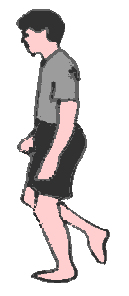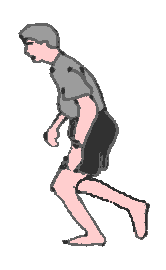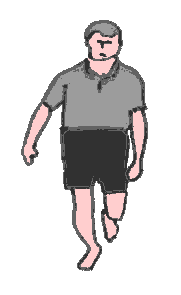|
|
|---|
- Perform this exercise barefoot!
- Standing on a cushion will add an incredibly useful
"proprioceptive" component!
- Sore knees? - support
your weight by placing your hands on the backs of two chairs.
The Runner's Squat:- Start Position
- Review the instructions for correct standing.
- From "Correct Standing", lift your right foot off the ground by bending at the knee.
Keep your pelvis pointing straight ahead.
- Form your left foot arch & make sure that your left knee is pointing forward,
or even a little outward, and tense the left gluteals
- Scapulas anchored pelvic neutral, head bouyant on spine.
The Runner's Squat:- Action
- Breathe in, zip & hollow, clench left buttock.
- (Breathing out): Lower on your left leg. Your back and tibia remain parallel with each other.
Your knee angle should not go below 135 degrees.
- Hold for one to two seconds, then (breathing in): rise up.
- Repeat five to 10 times both sides, & on the last repeat, hold the squat for 10 seconds..
- Do the same for the other leg.
(Scroll right>>>>....)
|
The Runner's Squat:
|
Start Position

|
Action


|
Comments
- This exercise helps to correct "sway back"
- The author loves this exercise: he cooks breakfast and
looks after his back at the same time (see ref. 4)!
Watch Points
-
Maintain an elongating spine & stable pelvis.
- Keep the supporting leg's knee pointing outward.
- To really make this exercise work for you, engage your Gluteus maximus!
|
What it does
Westerners have developed a lazy Gluteus maximus and foot arches. This is due to over comfortable shoeing
(4). This exercise will help to correct
both of these faults, and therefore aid in reducing symptoms of poor Gluteus maximus function.
Symptoms include:
- Lower back pain.
- Iliotibial band friction syndrome.
- many forms of knee pain in general.
- Plantar fasciitis.
- Posterior Gluteus medius strain.
Reference
- Shirley A Sahrmann: Diagnosis and Treatment of Movement Impairment Syndromes;
Publ. Mosby 2002 ISBN 0-8016-7205-8
- Owen Anderson: How safe is squatting? (Article at http://www.pponline.co.uk/encyc/0827.htm)
- MY Yessis: Explosive Running Publ. Contemporary Books Chicago, 2000 Il ISBN 0-8092-9899-6
- Bruce Thomson: Engage Gluteus maximus!
© Bruce Thomson, EasyVigour Project
scroll up^^^^.....
|


